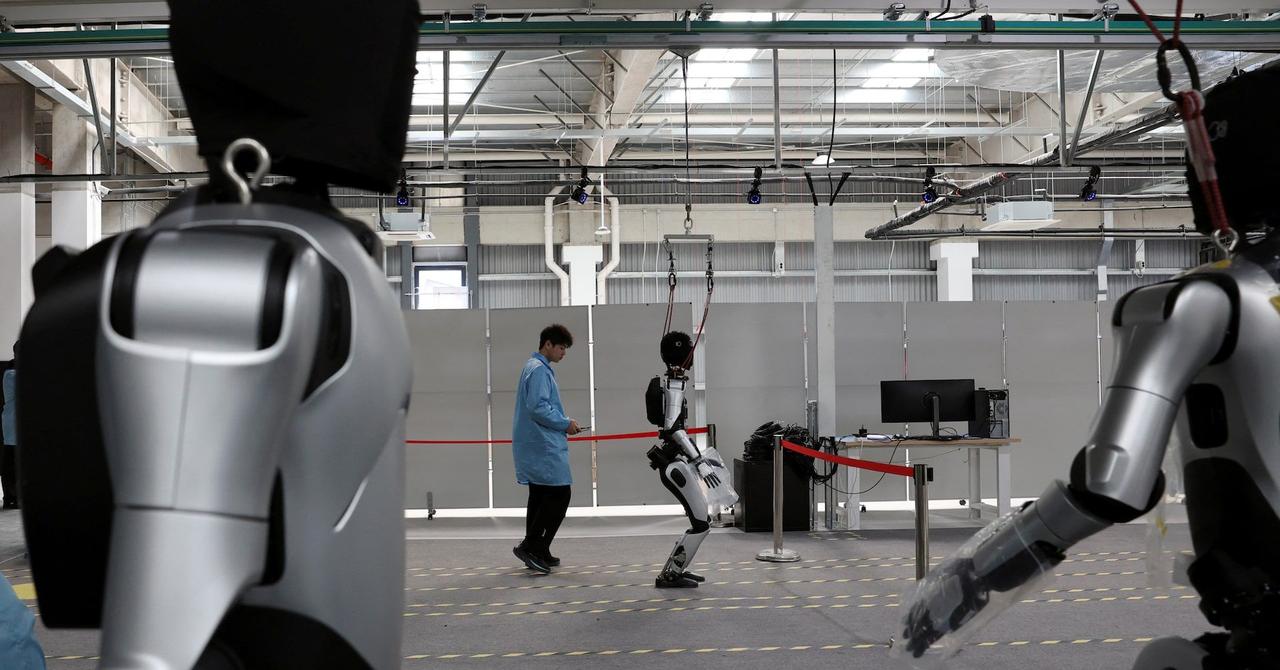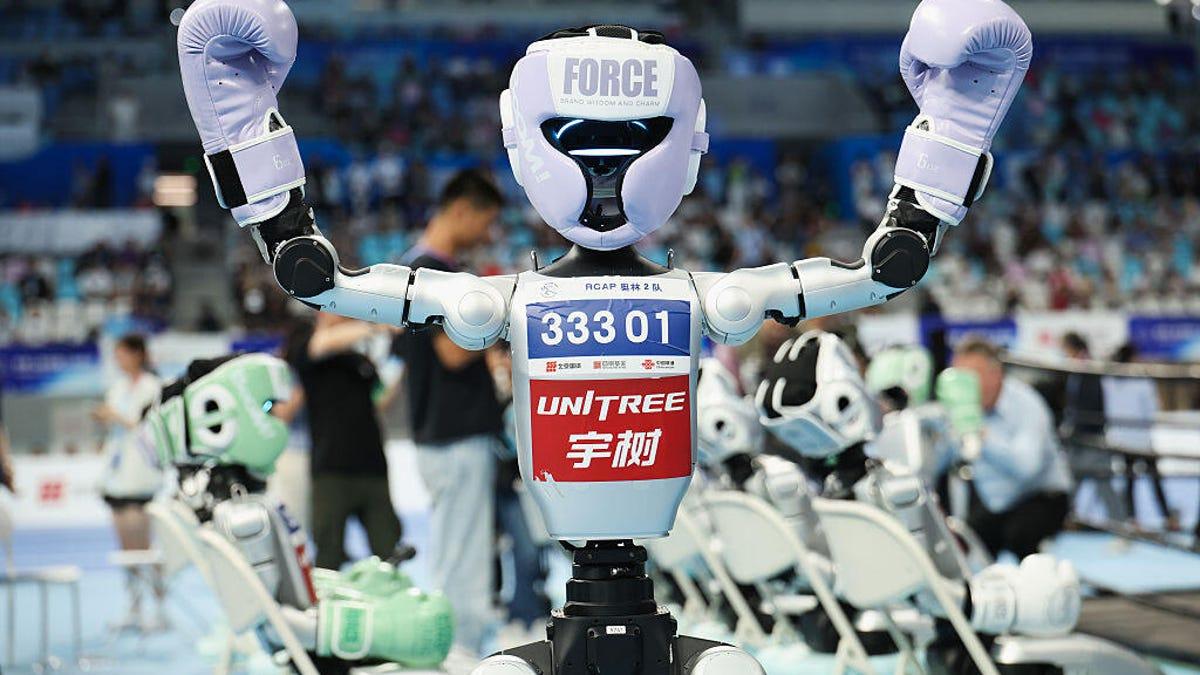China's Robot Conference Showcases Advancements in Humanoid Technology
3 Sources
3 Sources
[1]
China robots conference spotlights the changing face of humanoids
BEIJING (Reuters) - As China seeks to race ahead in humanoid robot development, its supply chains showcased cheaper and innovative parts at the world robot conference in Beijing, but some executives warn the industry has yet to improve product reliability. Wisson Technology (Shenzhen), known for its flexible robotic manipulators, doesn't depend on motors and reducers - transmission devices commonly used in robotics - but instead uses 3D-printed plastics and relies on pneumatic artificial muscles to power its robots. This less expensive form of production allows it to price its flexible arms at about one-tenth that of traditional robotic arms, said Cao Wei, an investor in Wisson through venture capital firm Lanchi Ventures, in which he is a partner. Pliable technology will usher in robotic arms at a cost of around 10,000 yuan ($1,404), Wisson said on its website. "(Wisson's) pliable arms could be used in humanoids," said Cao, adding that the company has already provided samples to overseas companies that make humanoid robots, without elaborating. Yi Gang, founder of Shanghai-based Ti5 Robot, a company specialising in integrated joints, highlighted some of the problems he sees in the robotics supply chain. "The whole supply chain still needs to address issues with product reliability," said Yi, adding that due to defect rates his company can only make products in volumes of up to 1,000. Harmonic gear, which refers to machinery that plays a key role in motion-control, was a key issue, he said. China's robotics effort is backed by President Xi Jinping's policy of developing "new productive forces" in technology - a point made in brochures for last week's event. Across China, the world's largest market for industrial robots, the increasingly sophisticated technology is changing the face of traditional industries such as manufacturing, autos, agriculture, education as well as health and home services. Gao Jiyang, previously an executive director at Chinese autonomous driving start-up Momenta before founding Galaxea AI, a start-up focused on robot hardware and embodied AI, said the ramp-up in smart driving was leading to advances in robotics. "Autonomous driving means AI-plus cars, which are also a type of robot," Gao said. As the conference wrapped up on Sunday, Premier Li Qiang said it was crucial to implement President Xi's guidelines on the importance of the robot industry. "The robot industry has broad prospects and huge market potential," Li said, according to China's official Xinhua news agency. Describing robots as an "important yardstick for technical innovation and high-end manufacturing strength," Li called for efforts to maintain supply chain stability and progress on the international stage. "It is necessary ... to promote the expansion and popularisation of robots in various fields such as industry, agriculture and service industry," he said. (Reporting By Qiaoyi Li and Kevin Krolicki in Beijing; Writing by Anne Marie Roantree; Editing by Michael Perry)
[2]
China robot conference spotlights the changing face of humanoids
As China seeks to race ahead in humanoid robot development, its supply chains showcased cheaper and innovative parts at the world robot conference in Beijing, but some executives warn the industry has yet to improve product reliability. Wisson Technology (Shenzhen), known for its flexible robotic manipulators, doesn't depend on motors and reducers - transmission devices commonly used in robotics - but instead uses 3D-printed plastics and relies on pneumatic artificial muscles to power its robots. This less expensive form of production allows it to price its flexible arms at about one-tenth that of traditional robotic arms, said Cao Wei, an investor in Wisson through venture capital firm Lanchi Ventures, in which he is a partner. Pliable technology will usher in robotic arms at a cost of around $1,404, Wisson said on its website. Wisson's "pliable arms could be used in humanoids," said Cao, adding that the company has already provided samples to overseas companies that make humanoid robots, without elaborating. Yi Gang, founder of Shanghai-based Ti5 Robot, a company specializing in integrated joints, highlighted some of the problems he sees in the robotics supply chain. "The whole supply chain still needs to address issues with product reliability," said Yi, adding that, due to defect rates, his company can only make products in volumes of up to 1,000. Harmonic gear, which refers to machinery that plays a key role in motion-control, was a key issue, he said. China's robotics effort is backed by President Xi Jinping's policy of developing "new productive forces" in technology - a point made in brochures for last week's event. Across China, the world's largest market for industrial robots, the increasingly sophisticated technology is changing the face of traditional industries such as manufacturing, autos, agriculture, education as well as health and home services. Gao Jiyang, previously an executive director at Chinese autonomous driving start-up Momenta before founding Galaxea AI, a start-up focused on robot hardware and embodied AI, said the ramp-up in smart driving was leading to advances in robotics. "Autonomous driving means AI-plus cars, which are also a type of robot," Gao said. As the conference wrapped up on Sunday, Premier Li Qiang said it was crucial to implement President Xi's guidelines on the importance of the robot industry. "The robot industry has broad prospects and huge market potential," Li said, according to China's official Xinhua news agency. Describing robots as an "important yardstick for technical innovation and high-end manufacturing strength," Li called for efforts to maintain supply chain stability and progress on the international stage. "It is necessary ... to promote the expansion and popularization of robots in various fields such as industry, agriculture and service industry," he said.
[3]
China robots conference spotlights the changing face of humanoids
This less expensive form of production allows it to price its flexible arms at about one-tenth that of traditional robotic arms, said Cao Wei, an investor in Wisson through venture capital firm Lanchi Ventures, in which he is a partner. Pliable technology will usher in robotic arms at a cost of around 10,000 yuan ($1,404), Wisson said on its website. "(Wisson's) pliable arms could be used in humanoids," said Cao, adding that the company has already provided samples to overseas companies that make humanoid robots, without elaborating. Yi Gang, founder of Shanghai-based Ti5 Robot, a company specialising in integrated joints, highlighted some of the problems he sees in the robotics supply chain. "The whole supply chain still needs to address issues with product reliability," said Yi, adding that due to defect rates his company can only make products in volumes of up to 1,000. Harmonic gear, which refers to machinery that plays a key role in motion-control, was a key issue, he said. China's robotics effort is backed by President Xi Jinping's policy of developing "new productive forces" in technology - a point made in brochures for last week's event. Across China, the world's largest market for industrial robots, the increasingly sophisticated technology is changing the face of traditional industries such as manufacturing, autos, agriculture, education as well as health and home services. Gao Jiyang, previously an executive director at Chinese autonomous driving start-up Momenta before founding Galaxea AI, a start-up focused on robot hardware and embodied AI, said the ramp-up in smart driving was leading to advances in robotics. "Autonomous driving means AI-plus cars, which are also a type of robot," Gao said. As the conference wrapped up on Sunday, Premier Li Qiang said it was crucial to implement President Xi's guidelines on the importance of the robot industry. "The robot industry has broad prospects and huge market potential," Li said, according to China's official Xinhua news agency. Describing robots as an "important yardstick for technical innovation and high-end manufacturing strength," Li called for efforts to maintain supply chain stability and progress on the international stage. "It is necessary ... to promote the expansion and popularisation of robots in various fields such as industry, agriculture and service industry," he said. (Reporting By Qiaoyi Li and Kevin Krolicki in Beijing; Writing by Anne Marie Roantree; Editing by Michael Perry)
Share
Share
Copy Link
China's World Robot Conference 2024 in Beijing highlights the rapid progress in humanoid robot development, featuring impressive demonstrations of human-like capabilities and raising questions about the future of human-robot interactions.

Cutting-Edge Humanoid Robots Take Center Stage
The World Robot Conference 2024 in Beijing has become a focal point for showcasing China's latest advancements in humanoid robot technology. The event, which has drawn significant attention from both industry experts and the public, highlights the rapid progress being made in creating robots that closely mimic human appearance and capabilities
1
.Impressive Demonstrations of Human-Like Abilities
Visitors to the conference were treated to remarkable displays of humanoid robots performing various tasks with unprecedented precision. One of the standout demonstrations featured a robot executing tai chi movements with fluid grace, showcasing the advancements in robotic motion control and balance
2
. Another robot, resembling a young woman, demonstrated its ability to respond to voice commands and engage in basic conversations, illustrating progress in natural language processing and artificial intelligence integration.The Rise of China's Robotics Industry
China's push to become a global leader in robotics is evident in the scale and sophistication of the technologies on display. The country has been investing heavily in research and development, aiming to position itself at the forefront of the robotics revolution. This effort is part of a broader strategy to upgrade its manufacturing capabilities and address demographic challenges such as an aging population
3
.Ethical and Social Implications
As humanoid robots become increasingly lifelike, the conference has sparked discussions about the ethical and social implications of this technology. Questions about the potential impact on employment, privacy, and human-robot relationships are being raised by experts and attendees alike
2
. The uncanny valley effect – the discomfort some people feel when encountering highly realistic humanoid robots – is also a topic of debate among conference participants.Related Stories
Future Applications and Market Potential
Industry analysts at the conference highlighted the vast potential applications for humanoid robots across various sectors. From healthcare and elderly care to customer service and entertainment, the versatility of these advanced robots is expected to drive significant market growth in the coming years
1
. Companies are already exploring ways to integrate humanoid robots into their operations, anticipating increased efficiency and novel customer experiences.International Collaboration and Competition
While the conference primarily showcases Chinese innovations, it also serves as a platform for international collaboration and competition in the field of robotics. Foreign companies and researchers are present, fostering a global exchange of ideas and technologies. However, the event also underscores the intensifying technological race between nations, particularly between China and other leading tech powers like the United States and Japan
3
.References
Summarized by
Navi
[1]
Related Stories
Recent Highlights
1
OpenAI releases GPT-5.2 AI model after code red memo targets Google's Gemini 3 threat
Technology

2
Disney invests $1 billion in OpenAI, licenses 200+ characters for Sora video generator
Technology

3
Disney accuses Google of massive copyright infringement through AI-generated character images
Policy and Regulation








